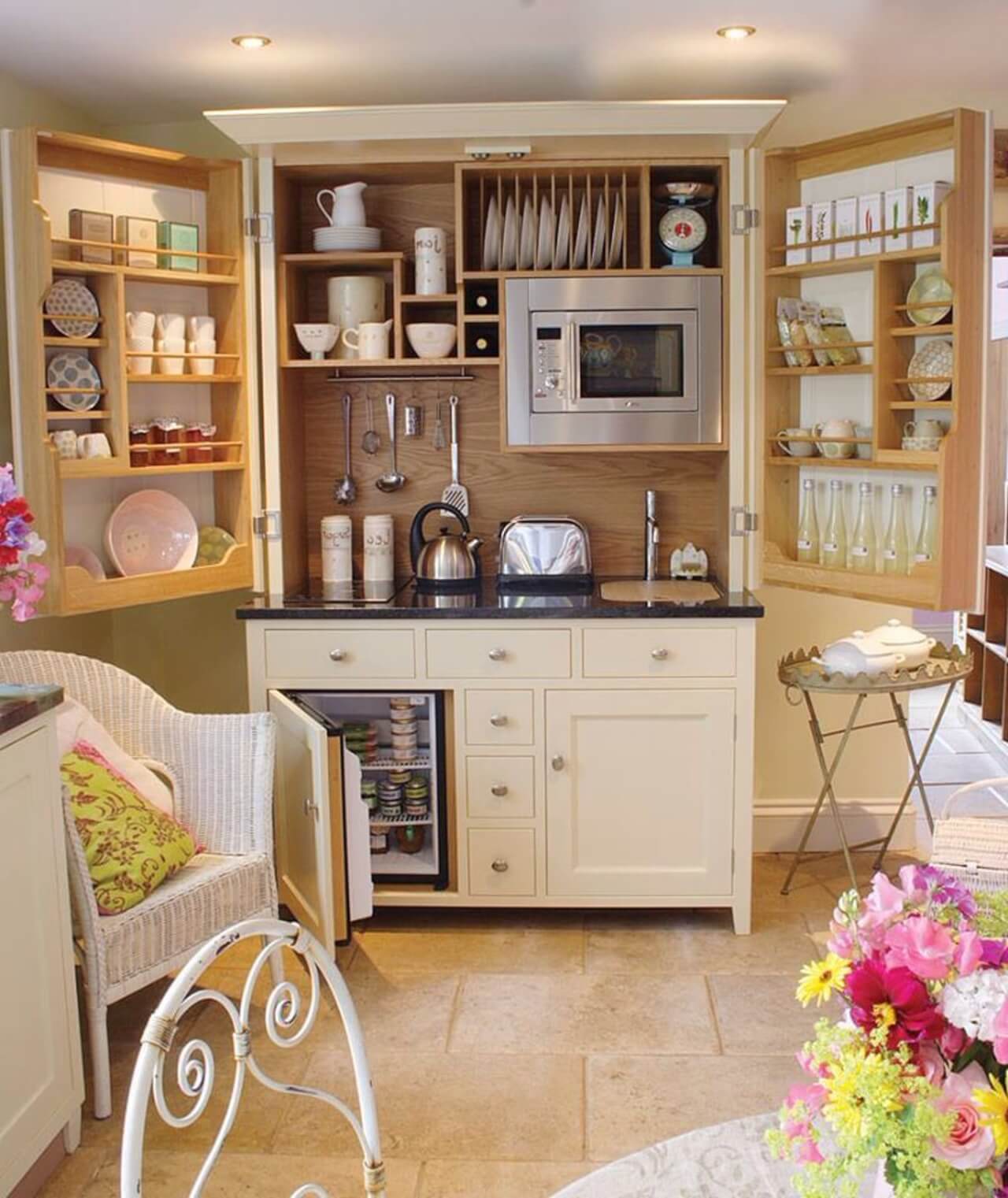This guide provides practical designs, inspiring ideas, and pro tips to help you maximize your tiny home kitchen space. From appliances to storage solutions, we’ll cover everything you need to create a functional and stylish kitchen, whether you’re a seasoned tiny homeowner or just starting your journey. Building a tiny home is a great way to live a more sustainable and affordable lifestyle. If you’re interested in building your own tiny home, you can purchase a tiny home kit that includes all of the materials you need to get started.
Designing Your Dream Tiny Kitchen
Designing a tiny home kitchen presents unique challenges, but also exciting opportunities for creative solutions. Let’s break down the key elements:
1. Layout: Maximizing Flow and Functionality
The layout is the foundation of your tiny kitchen. Consider these popular options:
-
Galley Kitchen: This classic corridor-style is perfect for narrow spaces, maximizing counter space and efficiency. Think of it as a streamlined workspace for your culinary adventures.
-
U-Shaped Kitchen: This layout offers ample counter space and storage, but may require more square footage. It’s perfect for those who prioritize having everything within easy reach.
-
Single-Wall Kitchen: Ideal for maximizing floor space in the tiniest of kitchens, this minimalist layout keeps things simple and efficient. It’s a popular choice for studio apartments and smaller tiny homes.
-
Kitchen Island (If Space Allows): Even a small island can add valuable prep space, storage, or a spot to eat. Multi-functional furniture is key in tiny living! A rolling island offers flexibility, allowing you to move it as needed.
-
Loft Kitchen: For tiny homes with high ceilings, a loft kitchen can be a unique solution to maximize square footage. However, carefully consider accessibility and safety.
2. Appliances: Smart Choices for Small Spaces
Choosing the right appliances can significantly impact your tiny kitchen’s functionality:
-
Downsized Appliances: Apartment-size refrigerators, 2-burner cooktops, and compact ovens offer surprising functionality without consuming precious space. They are designed specifically for smaller kitchens.
-
Combination Appliances: A microwave-convection oven serves double duty, saving valuable counter space. Assess your cooking habits and consider which appliances you can combine.
-
Prioritize Your Needs: Before purchasing appliances, honestly evaluate your cooking style. Are you a gourmet chef requiring a larger cooktop or someone who prefers quick meals using a microwave?
3. Storage: Creative Solutions for a Clutter-Free Kitchen
Storage is paramount in a tiny kitchen. Here’s how to maximize every inch:
-
Vertical Storage: Floor-to-ceiling cabinets are your space-saving superheroes, maximizing vertical space and keeping everything organized.
-
Under-Sink Storage: Don’t neglect this often-overlooked area. Sliding drawers or shelves can transform this awkward space into a valuable storage zone.
-
Drawer Organizers: Keep drawers tidy and functional with dividers and organizers. They ensure everything has its designated place, preventing clutter.
-
Wall-Mounted Shelving: Open shelving or wall-mounted cabinets utilize vertical surfaces and add a touch of style. However, consider your personality and preference for open versus closed storage.
4. Sinks and Countertops: Small Details, Big Impact
Even small choices like sinks and countertops matter:
-
Sinks: A surprisingly deep, single-basin sink can be a godsend in a tiny kitchen, facilitating easier dishwashing and food prep.
-
Countertops: Durable materials like butcher block, laminate, or quartz withstand daily wear and tear. Consider lighter-weight options like bamboo for reduced overall weight, especially important in mobile tiny homes.
5. Design Aesthetics: Personalizing Your Tiny Paradise
Your tiny kitchen should reflect your style:
-
Style: Farmhouse, modern, minimalist—any style can work in a tiny home. Choose what resonates with you and creates the atmosphere you desire.
-
Color: Light and bright colors create the illusion of more space. Whites, creams, and light pastels are popular choices.
-
Lighting: Maximize natural light. Supplement with under-cabinet lighting to brighten your workspace and enhance functionality.
6. Budget & DIY: Creative Ways to Save
Creating your dream tiny kitchen doesn’t require a fortune:
-
Cabinet Refacing: Update your cabinets without replacing them entirely by refacing them. This is a cost-effective way to refresh your kitchen’s look.
-
Hardware Swaps: New handles and knobs can dramatically transform the look of your kitchen for a minimal investment.
-
Fresh Coat of Paint: Painting cabinets or walls revitalizes the space and injects personality. It’s a simple yet effective DIY project.
-
DIY Projects: If you’re handy, consider building open shelves, creating a unique backsplash, or repurposing materials for custom storage solutions.
Building Your Tiny Kitchen: A Step-by-Step Guide
Ready to build your tiny kitchen? Here’s a guide to get you started:
1. Planning Your Layout
-
Measure Your Space: Accurate measurements are crucial. Know your limitations and plan accordingly.
-
Choose Your Layout: Consider the options discussed earlier (galley, U-shaped, L-shaped, single-wall) and select the one that best suits your space and lifestyle.
-
Create a Design: Sketch your layout or use design software to visualize the space and ensure everything fits.
2. Selecting Appliances and Fixtures
-
Prioritize Needs: Consider your cooking habits and choose appliances that align with them.
-
Measure Appliances: Ensure your chosen appliances fit within your designated spaces. Don’t forget to account for clearances for doors and drawers.
-
Choose Fixtures: Select a sink, faucet, and lighting that are both functional and aesthetically pleasing.
3. Optimizing Space
- Vertical Storage: Plan for wall-mounted cabinets, shelves, and hanging racks.
- Multi-Functional Furniture: Consider a fold-down table, a convertible island, or a rolling cart for added flexibility.
- Hidden Storage: Explore opportunities for hidden storage compartments, such as drawers under the sink or cabinets above the refrigerator.
4. Installation
- Plumbing and Electrical: If you’re not comfortable with these tasks, hire licensed professionals. Improper installation can be dangerous and costly to fix.
- Cabinets and Countertops: Install cabinets securely and level countertops accurately.
- Appliances: Install appliances according to manufacturer instructions, ensuring proper ventilation and connections.
5. Finishing Touches
- Paint and Decor: Add a fresh coat of paint and incorporate decorative elements that reflect your style and make the space feel inviting.
- Organization: Implement storage solutions to keep your kitchen clutter-free and functional.
Tiny Kitchen FAQs
What size is a normal kitchen in a tiny house?
There’s no single “normal” size. It depends on the overall size of your tiny house and your lifestyle. Kitchens in tiny homes can range from as small as 30 square feet to around 70 square feet. Some prioritize a larger living area and minimize the kitchen, while others, especially passionate cooks, may prioritize a larger kitchen space. The average likely falls between 50 and 70 square feet.
What kitchen layout is popular in small homes?
Galley and L-shaped kitchens are popular choices for small homes, including tiny houses. They both offer efficient use of space and good workflow. Galley kitchens are ideal for narrow spaces, while L-shaped kitchens can define a kitchen zone in an open-plan layout. Single-wall kitchens are also a good option for maximizing open floor space in very small homes. The choice ultimately depends on your specific needs and preferences.
Tiny Kitchen Resources
There are many resources available to help you design and build your perfect tiny home kitchen.
-
Online Forums: Connect with other tiny house enthusiasts and share ideas and advice. Some popular forums and communities provide a wealth of information on tiny house living, including kitchen design.
-
Blogs and Websites: Numerous blogs and websites dedicated to tiny house living offer inspiration, tips, and practical advice. Some may even show construction plans for DIY projects.
-
YouTube Tutorials: YouTube channels devoted to DIY, tiny house building, and woodworking are excellent resources for visual learners. Many videos demonstrate step-by-step instructions for tiny house kitchen construction and design.
-
Tiny House Shows and Documentaries: These can provide inspiration and showcase a variety of kitchen layouts and designs in real-world tiny homes. They can also offer useful tips on storage solutions and appliance choices.
Remember, designing your tiny home kitchen is a journey of discovery. Embrace the challenge, have fun, and create a space that is both functional and a reflection of your unique style.
- Modern Mexican Interior Design: Create a Vibrant Home - September 12, 2025
- Discover Zimbabwe Traditional Interior Design: A Modern Guide - September 8, 2025
- Master Interior Design Online: Fast Track Your Career - September 5, 2025










